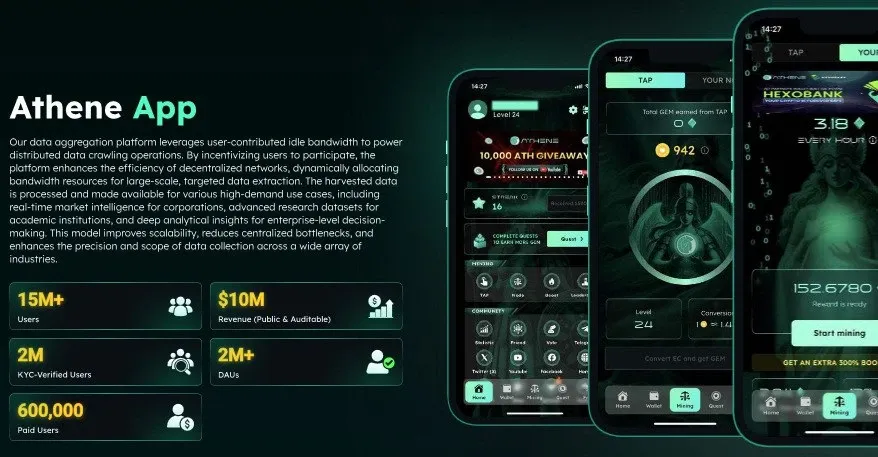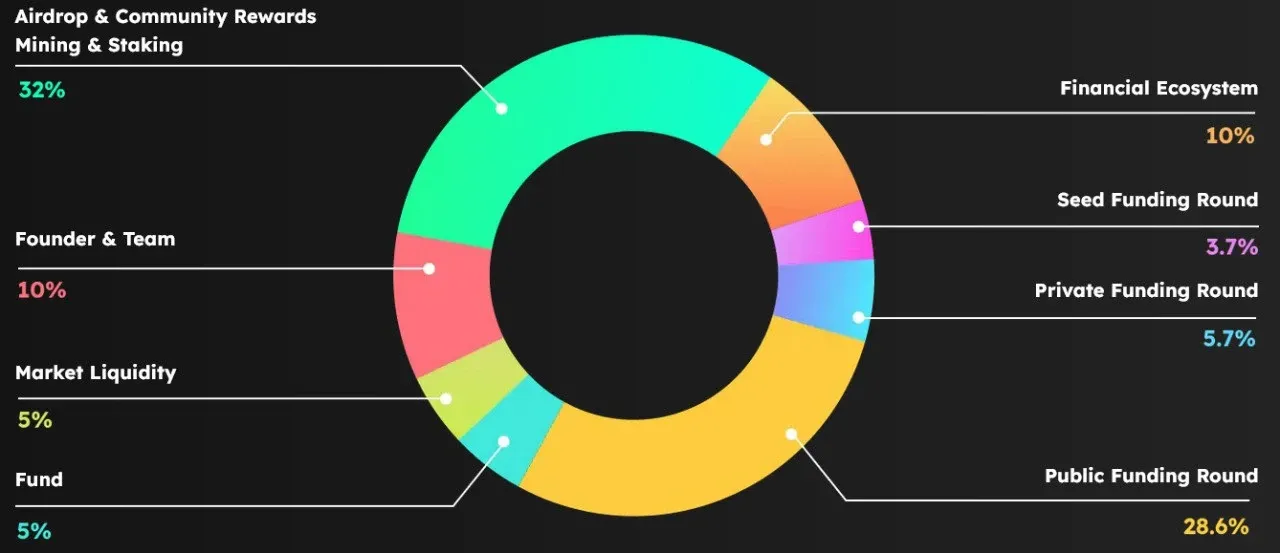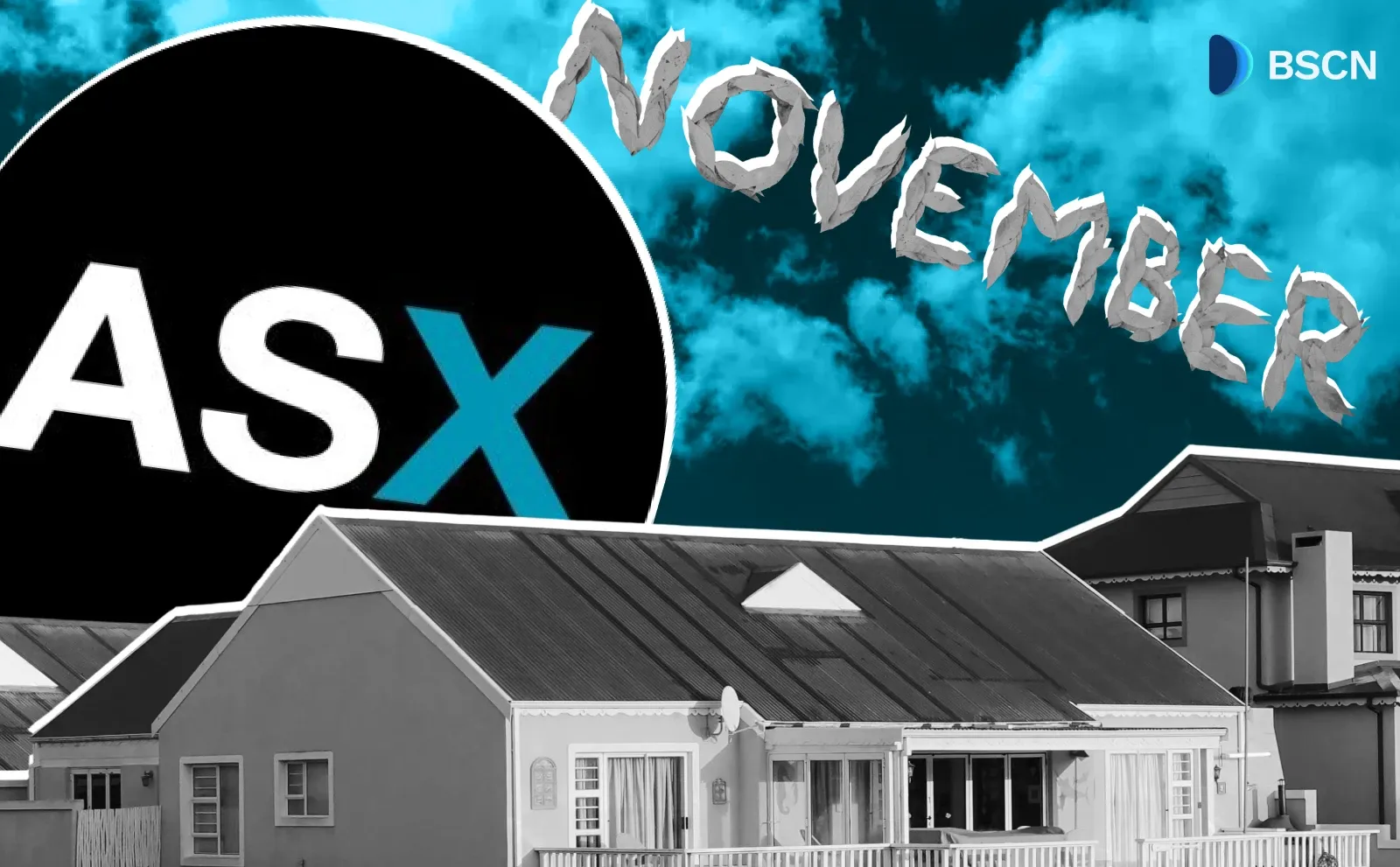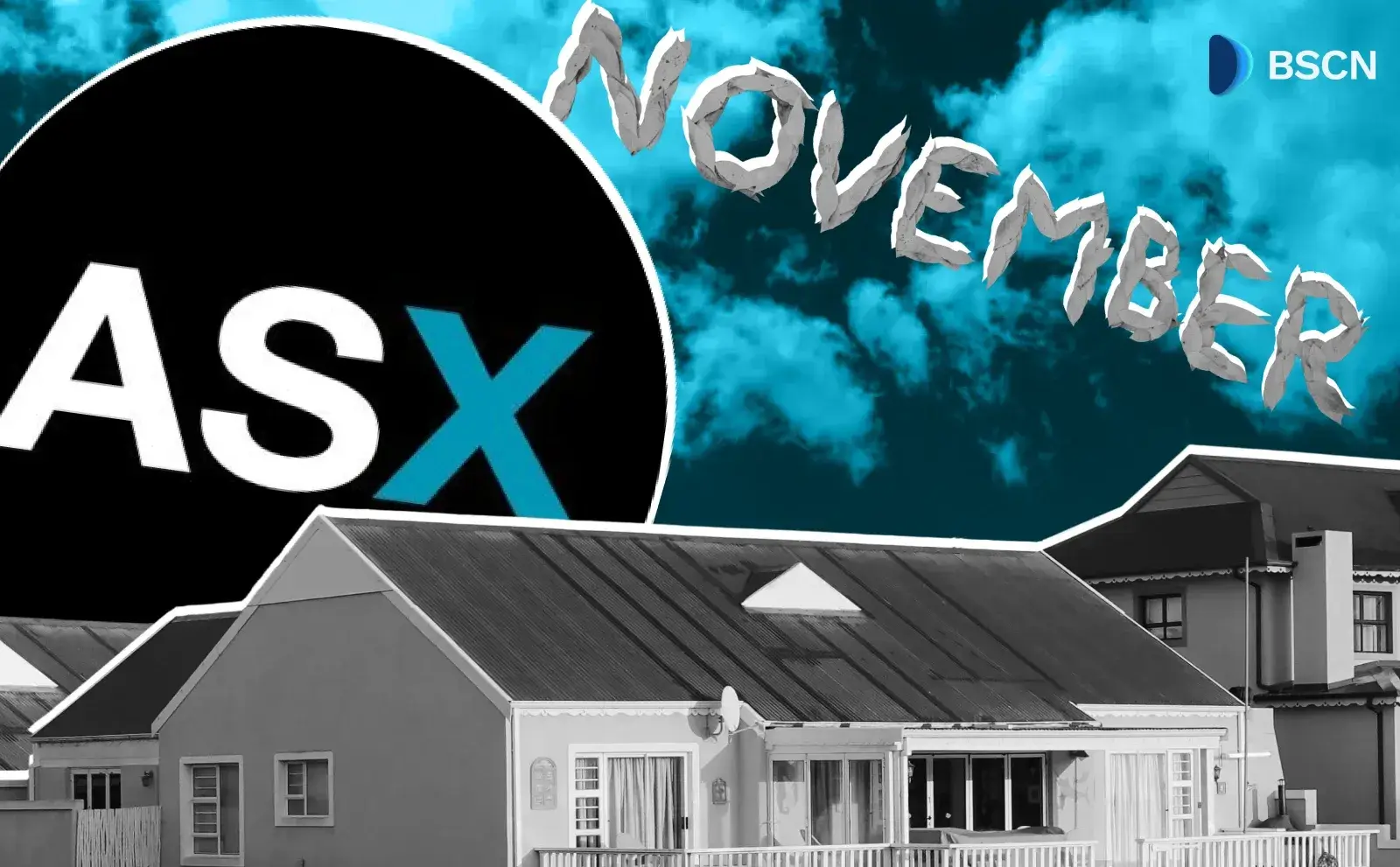Deepdive
(Advertisement)
What is Athene Network and the ATN Token?

Athene Network claims 15M+ users in its AI-blockchain ecosystem, but delays and transparency issues raise questions. Explore its technology, tokenomics, and the April 16, 2025, token unlock.
Crypto Rich
March 26, 2025
(Advertisement)
Table of Contents
The Athene Network started in late 2023, promising to revolutionize decentralized finance (DeFi) by blending artificial intelligence with blockchain technology. With a reported 15 million users and a mobile-first approach to mining and trading, the project has garnered significant attention. Yet, repeated delays---most recently a token unlock pushed to April 16, 2025---and growing community skepticism cast doubt on its execution. This deep dive explores Athene's technology, ecosystem components, tokenomics, and recent developments to assess whether it can deliver on its ambitious vision of a "limitless network."
What is Athene Network?
Origins and Vision
Athene Network launched in October 2023 as a mobile mining and DeFi project, positioning itself at the intersection of artificial intelligence and blockchain technology. Details about its founding team and headquarters remain scarce. The lack of transparency has led some observers to describe it as a "hype-driven startup."
The project's vision, according to its official documentation, is to "create a limitless network" by combining blockchain's decentralization with AI's data processing capabilities. Athene focuses on three key areas:
- Decentralized finance (DeFi) applications
- Digital asset management tools
- AI-driven solutions for market research and sentiment analysis
Its core mission aims to build a scalable, secure platform where users can mine, trade, and manage digital assets while leveraging AI for market insights. This approach targets both accessibility and functionality for users, regardless of technical expertise.
Technology and Innovation
Blockchain Architecture
Athene Network, a layer two on top of Ethereum, utilizes a Proof-of-Stake (PoS) consensus mechanism. Their approach offers several advantages over traditional Proof-of-Work (PoW) systems:
- Energy Efficiency: PoS consumes significantly less power than mining-based systems
- Broader Participation: Validators are selected based on their staked ATN tokens rather than computing power
- Reduced Centralization Risk: Avoids the mining pool concentration seen in PoW networks
The planned network's governance system will allow token holders to vote on protocol upgrades, creating a more decentralized decision-making process.
Blockchain Performance
Athene's blockchain infrastructure boasts several technical capabilities:
- 4,000 transactions per second (TPS) on the testnet
- Block times of 2 seconds or less
- Fast transaction finality that reduces the risk of reversals
- Developer-friendly ecosystem that enhances Ethereum EVM access
- Competitive gas fees to make transactions more affordable
According to their marketing materials, the "Athene Parthenon" (their blockchain system) supports these fast block production times while maintaining full decentralization, giving users complete control over assets without intermediaries.
These performance metrics, while impressive on paper, remain confined to the testnet environment as the project continues to work toward a mainnet launch—a critical milestone that has seen significant postponements, as we'll explore later in the Recent Developments section.
AI Integration
Athene Network's AI integration claims to offer several functionalities:
- Smart Contracts Automation: AI-powered smart contracts that execute automatically based on conditions, enabling real-time decisions for finance, supply chain, and IoT applications.
- Efficiency Optimization: AI systems that adjust block sizes and prioritize transactions to prevent congestion and reduce delays during high traffic periods.
- Data Integrity and Trust: Using blockchain's transparent, immutable structure to ensure accurate data for AI models and boost the reliability of automated decisions.
- User Experience Enhancement: AI systems that continuously adapt and learn from user interactions to keep the platform responsive to community needs.
- Educational Resources: AI-driven tools to help users navigate the complexities of blockchain and digital assets.
- Fairness and Accountability: Blockchain records of every AI training step, ensuring transparency and creating an audit trail to confirm fairness and prevent bias in algorithms.
- Security and Privacy Enhancement: Blockchain's decentralized, tamper-proof ledger safeguarding sensitive data, with smart contracts regulating access to ensure secure storage for AI applications.
- Democratized AI Training: Distribution of training across a decentralized network to foster innovation and avoid centralization risks like bottlenecks or failures.
The company positions this AI-blockchain integration as creating a "limitless network" that democratizes access to both technologies. According to their materials, Athene is "committed to making AI accessible to everyone" with an AI layer designed to "democratize knowledge by offering educational resources."
However, technical documentation provides limited details about implementation methods or specific algorithms used. While the high-level use cases are compelling, the lack of technical specifics contrasts with more transparent AI-blockchain projects that openly document their technologies and methodologies.
Competitive Edge
When compared to established AI-blockchain projects like Fetch.AI or Ocean Protocol, Athene offers some potential differentiators:
- Mobile-first approach with accessible mining
- PoS blockchain with (future) governance features
- Broader focus on everyday users rather than specialized data markets
However, this approach remains unproven at scale, and technical documentation lacks the depth found in more mature projects.

Athene Ecosystem Breakdown
Athene Mining App
The mobile mining application "Athene Network" serves as the entry point for many users. Available on both iOS and Android platforms, it allows users to earn ATN tokens through "mining" activities that don't require specialized hardware. The app also features engagement mechanisms to increase user participation and reward distribution.

P2P Trading Platform
Athene's peer-to-peer trading platform represents one of its most successful components. As of March 2025, it reportedly hosts over 2.1 million users and has generated more than $22 million in revenue. The platform supports trading of various digital assets, including the Pi token, providing an entry point for users new to cryptocurrency trading.
Telegram Mini App
The Telegram "Athene Mini App" has become a key engagement tool for Athene Network. By January 2025, this component had attracted over 1.5 million users, 190,000+ active monthly users, making it an important part of their ecosystem.
Athenescan (Public Testnet)
Athene Parthenon explorer, the project's public testnet explorer, demonstrates promising technical capabilities with 4,000 transactions per second (TPS) and block times of two seconds or less. This component offers transparency into network transactions and performance metrics. Developers have also added a bridge and faucet to enhance the testnet's functionality.
Athene Wallet
Athene has successfully also launched a wallet, available as a Chrome browser extension. The wallet allows users to securely store, send, and receive ATN tokens and other supported cryptocurrencies, while providing an intuitive interface for managing digital assets.
Athene Prediction Markets
Athene also launched its prediction markets platform, allowing users to forecast future Bitcoin prices. This feature enables participants to leverage their knowledge and insights to earn rewards. Fitting in Athene's growing ecosystem of decentralized applications.
Future Components
Additional components remain in development, including:
- Athene Foundation for ecosystem governance
- Athene DEX
These align with the project's broader DeFi vision, and the team continues to work on expanding their ecosystem functionality.
While Athene has successfully launched several components of its ecosystem, the roadmap for these future developments has been affected by the same timeline challenges impacting the mainnet launch. This creates an interesting tension between the project's delivered capabilities and its ambitious vision, which we'll examine further when discussing recent developments and community sentiment.
The ATN Token and Ongoing Presale
ATN Tokenomics
According to CoinMarketCap data, Athene Network has a total supply of 2.1 billion ATN tokens and 4.7 million tokens in circulation.
The token allocation is structured as follows:
- 32% - Airdrop & Community Rewards, Mining & Staking
- 28.6% - Public Funding Round
- 10% - Financial Ecosystem
- 10% - Founder & Team
- 5.7% - Private Funding Round
- 5% - Market Liquidity
- 5% - Fund
- 3.7% - Seed Funding Round
This distribution suggests a significant focus on community engagement and public participation, with over 60% of tokens allocated to public sale, airdrops, mining, and staking rewards.

The ATN token serves multiple functions within the ecosystem:
- Transaction fees for network operations
- Staking for validators to secure the network
- Governance voting on protocol upgrades (planned)
- In-app rewards for activities like mining and gaming
Presale Details
The Athene Network presale continues at athene.network. Originally scheduled to end on March 20, the deadline has been extended to April 16, 2025. This extension represents one of several delays that have affected the project's roadmap.
According to a March 25 social media post , Athene introduced a token lock program designed to reduce circulation and boost price stability. The same announcement mentioned ongoing negotiations with investment funds to support growth, framing the delay as a strategic move rather than a technical necessity.
To drive participation, Athene offers several incentives:
- $20 reward for completing KYC verification
- 12% USDT referral bonus
- $1 million USDT prize pool
The token unlock schedule specifies:
- Public sale tokens unlock on April 16, 2025
- Angel, In-App, and Parthenon round tokens unlock on April 20, 2025
Exchange Listings
ATN tokens are currently available on BingX and MEXC exchanges, with several other exchange listings confirmed. The unusual overlap between ongoing presale activities and exchange listings has drawn criticism from community members, including X user @BreezyP250, who suggested this arrangement could be potentially problematic for early investors.
Claimed Market Position and User Statistics
Athene Network's marketing materials present impressive adoption metrics:
- Present in 230 countries
- 15M+ total users
- 2M+ daily active users (DAUs)
- $1M+ in monthly revenue
- $25M+ raised in funding
- 600K+ premium users
These figures represent a significant increase from earlier reports from a January 2025 social media post mentioning 4.5 million users. The leap to 15 million represents over 230% growth in a matter of months with no clear explanation for this dramatic increase.
Several factors may explain these discrepancies:
- Different counting methodologies (registered vs. active users)
- Inclusion of different platform components in the total
- Marketing-driven inflation of numbers
- Actual rapid growth due to successful user acquisition campaigns
The platform positions itself as a visionary project, stating that "Athene Network envisions a world where artificial intelligence and blockchain together redefine the foundations of our digital and social landscapes." Their marketing materials emphasize creating "a simple, accessible doorway that links individuals to technological advancements."
While these claims and statistics are ambitious, they should be evaluated in context of the project's operational challenges and delayed deliverables mentioned elsewhere in this analysis. The lack of consistent reporting methodology further complicates assessment of Athene's true market position.

Recent Developments (2025)
Project Delays
Athene Network's development timeline has been marked by a series of significant postponements that have raised concerns among stakeholders. The most notable setback involves the mainnet launch, originally scheduled for March 15, 2025. After missing this target date, the team announced a revised timeline pointing to late March, but as of this writing, the actual launch date remains undetermined with no clear communication about when users might expect this critical milestone.
Further compounding these concerns, the token unlock event was also pushed back from its initial March 25 date to April 16, 2025, creating uncertainty in the market. When pressed for explanations, project representatives have consistently cited two primary justifications: the need for additional rigorous testing to ensure platform security and stability, and ongoing negotiations with potential funding partners. These explanations, while reasonable on the surface, have been met with skepticism from community members who question whether these delays indicate deeper structural or technical challenges within the project.
These postponements don't exist in isolation but rather create ripple effects throughout the ecosystem development. The delayed mainnet impacts governance capabilities, while the token unlock extension influences market dynamics and investor confidence. Together, they form a pattern that has become a central narrative in the project's recent history.
User Engagement Initiatives
In response to the mounting concerns about delays, Athene has launched several strategic initiatives designed to maintain community engagement and momentum:
- $20 KYC completion reward program to incentivize user verification
- Expanded exchange presence with listings on MEXC, BingX, and confirmations of additional platforms
- Accelerated development and release of ecosystem components including the wallet, prediction markets, and continued work on the DEX
These efforts represent a deliberate attempt to shift focus away from timeline challenges and toward tangible progress in other areas of the project ecosystem.
Community Response and Sentiment
The operational challenges and timeline adjustments have sparked significant community reaction, creating a polarized landscape of user sentiment. On one side, project delays have triggered frustration among users who report a range of ongoing issues:
- KYC verification delays
- Withdrawal processing problems
- Concerns about the repeated postponements of mainnet launch and token generation events
These issues have eroded confidence in the project's execution capabilities for many community members. One user stated; "A shady project, no big investors, just a show here to attract fish." while another user wrote: "Confidence in the team has been shaken, I feel sorry for the money I have already invested, always be cautious." These comments represent a growing sentiment of discontent among some community members.
On the other hand, a substantial portion of the community maintains optimism about Athene's long-term potential. These supporters tend to focus on the technological innovations and reported user growth, viewing the current delays as temporary growing pains rather than fundamental flaws. They point to the successfully launched components like the wallet and prediction markets as evidence of ongoing progress despite timeline adjustments.
This community divide creates a complex social dynamic around the project, with current sentiment suggesting a community that remains engaged but increasingly cautious. Many users have adopted a "wait and see" approach, with the upcoming April milestones viewed as a decisive moment that will either validate patience or confirm skepticism.
Opportunities and Risks
Potential Opportunities
Despite the implementation challenges detailed above, Athene Network maintains several strengths that could drive future success if properly leveraged:
- Technological Foundation: The Proof-of-Stake blockchain with AI integration offers scalability and energy efficiency advantages over traditional systems
- Large User Base: With reported figures ranging from 5 million to 15 million users (though verification remains difficult), Athene has demonstrated significant market interest
- Comprehensive Ecosystem: The combination of mining, trading, and gaming creates multiple engagement pathways for users
- AI-Blockchain Integration: The platform claims several innovative use cases for combining AI with blockchain, including:
- Fairness and accountability through blockchain records of AI training
- Enhanced security and privacy for AI applications
- Smart contracts automation for real-time decision making
- Decentralized AI training across distributed networks
- Growing Market: Positioning in the expanding AI-blockchain sector could capture increasing investment flows
- Attractive Incentives: The referral system and rewards structure could continue driving user acquisition
These positive factors explain why many community members remain engaged despite the operational challenges. If Athene can overcome its current execution issues, these strengths provide a foundation for potential growth and adoption.
I'll list the article starting from the Significant Risks section:
Significant Risks
The challenges facing Athene Network are substantial and interconnected, creating a web of risks that potential investors and users should carefully evaluate:
- Development Timeline Issues: The pattern of repeated postponements indicates potential challenges in project management and execution capabilities, raising questions about the team's ability to deliver on future commitments
- Transparency Concerns: Limited information about the founding team, headquarters, and technical implementations reduces accountability and makes due diligence difficult for investors and community members
- Operational Friction: User-reported problems with KYC verification and withdrawals impact trust and usability, potentially hindering adoption regardless of technological merits
- Reporting Inconsistencies: The significant discrepancies in user statistics across marketing materials raise questions about data reliability and reporting standards
- Community Division: The growing skepticism among users and observers could create a negative feedback loop that hampers trust-building efforts
These risk factors don't exist in isolation but rather compound each other. For example, the lack of transparency exacerbates concerns about development delays, while operational challenges fuel community skepticism. This interconnected nature of the challenges makes them particularly difficult to address with isolated fixes.
Near-Term Outlook
Athene Network stands at a critical juncture, with its immediate future hinging on two pivotal events that will define its trajectory in the coming months:
- Successful completion of the token unlock on April 16, 2025
- Delivery of a functional mainnet with clear performance metrics
These milestones represent more than just technical achievements—they are crucial tests of the project's commitment to its roadmap and its ability to navigate implementation challenges. After the pattern of delays and adjustments documented throughout this analysis, successfully meeting these deadlines would represent a significant turning point, potentially rebuilding credibility and reinvigorating community support.
Conversely, any further postponements or execution issues would likely compound the existing concerns, potentially triggering more significant community backlash and undermining confidence in the project's fundamental viability. This binary dynamic creates a high-stakes environment for the Athene team as these critical dates approach.
Conclusion
Athene Network presents a study in contrasts—a project whose ambitions and claimed achievements stand somewhat at odds with its implementation realities. Its reported user growth of 15 million users and its impressive technical specifications—including a Proof-of-Stake blockchain capable of 4,000 TPS with AI integration—signal significant market interest and technological potential. These elements, combined with the successfully launched components of its ecosystem, demonstrate that Athene has established a foothold in the competitive cryptocurrency landscape.
However, this promising foundation is counterbalanced by the persistent challenges documented throughout this analysis. The pattern of timeline adjustments affecting the mainnet launch and token unlock, the transparency limitations regarding team and operations, and the growing community concerns collectively create substantive questions about execution capabilities. The disparity between reported user statistics and the operational friction experienced by existing users further complicates the evaluation of Athene's current position and future trajectory.
From a technological perspective, the project's foundation includes several elements that could drive future success if implementation challenges are overcome:
- Energy-efficient PoS consensus mechanism
- User-friendly mobile mining approach
- Integrated AI for market insights
For investors and users considering involvement with Athene Network, this mixed picture creates a high-risk, high-reward proposition. The project could indeed deliver substantial value if it successfully navigates its current challenges and executes its ambitious roadmap. However, continued operational issues and transparency concerns could equally undermine its long-term viability regardless of its technological merits.
Those interested in Athene Network would be well-advised to closely monitor the April 16 token unlock and subsequent mainnet launch with particular attention. These imminent milestones will provide critical signals about whether the project can transform its ambitious vision of a "limitless network" into practical reality—or whether it will join the growing list of cryptocurrency projects that struggled to bridge the gap between promising concepts and successful execution.
Read Next...
Disclaimer
Disclaimer: The views expressed in this article do not necessarily represent the views of BSCN. The information provided in this article is for educational and entertainment purposes only and should not be construed as investment advice, or advice of any kind. BSCN assumes no responsibility for any investment decisions made based on the information provided in this article. If you believe that the article should be amended, please reach out to the BSCN team by emailing [email protected].
Author
 Crypto Rich
Crypto RichRich has been researching cryptocurrency and blockchain technology for eight years and has served as a senior analyst at BSCN since its founding in 2020. He focuses on fundamental analysis of early-stage crypto projects and tokens and has published in-depth research reports on over 200 emerging protocols. Rich also writes about broader technology and scientific trends and maintains active involvement in the crypto community through X/Twitter Spaces, and leading industry events.
(Advertisement)
Latest News
(Advertisement)
Crypto Project & Token Reviews
Project & Token Reviews
Comprehensive reviews of crypto's most interesting projects and assets
Learn about the hottest projects & tokens
Latest Crypto News
Get up to date with the latest crypto news stories and events














